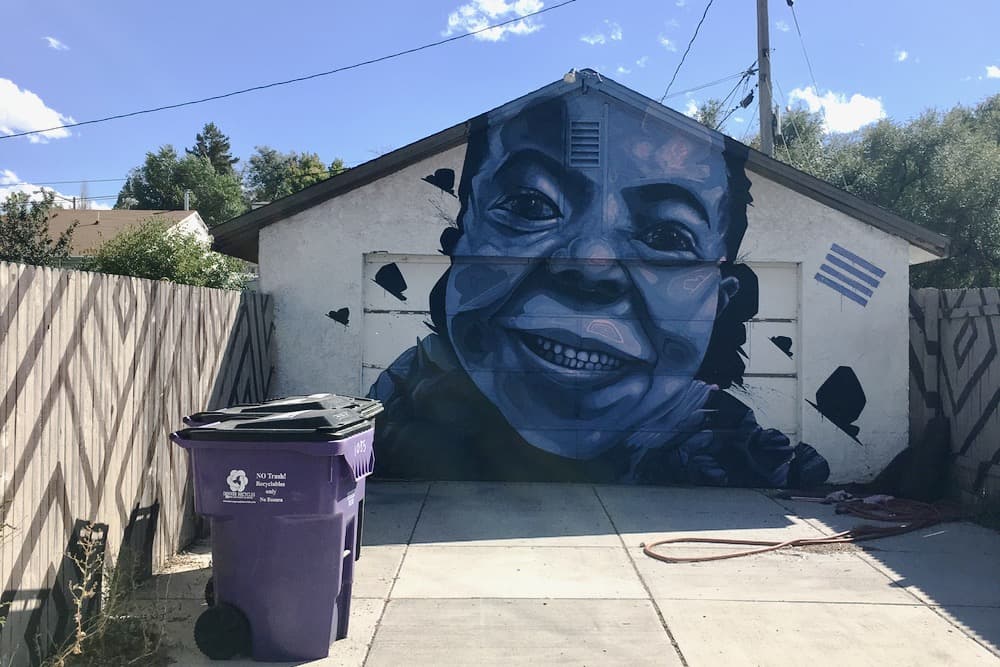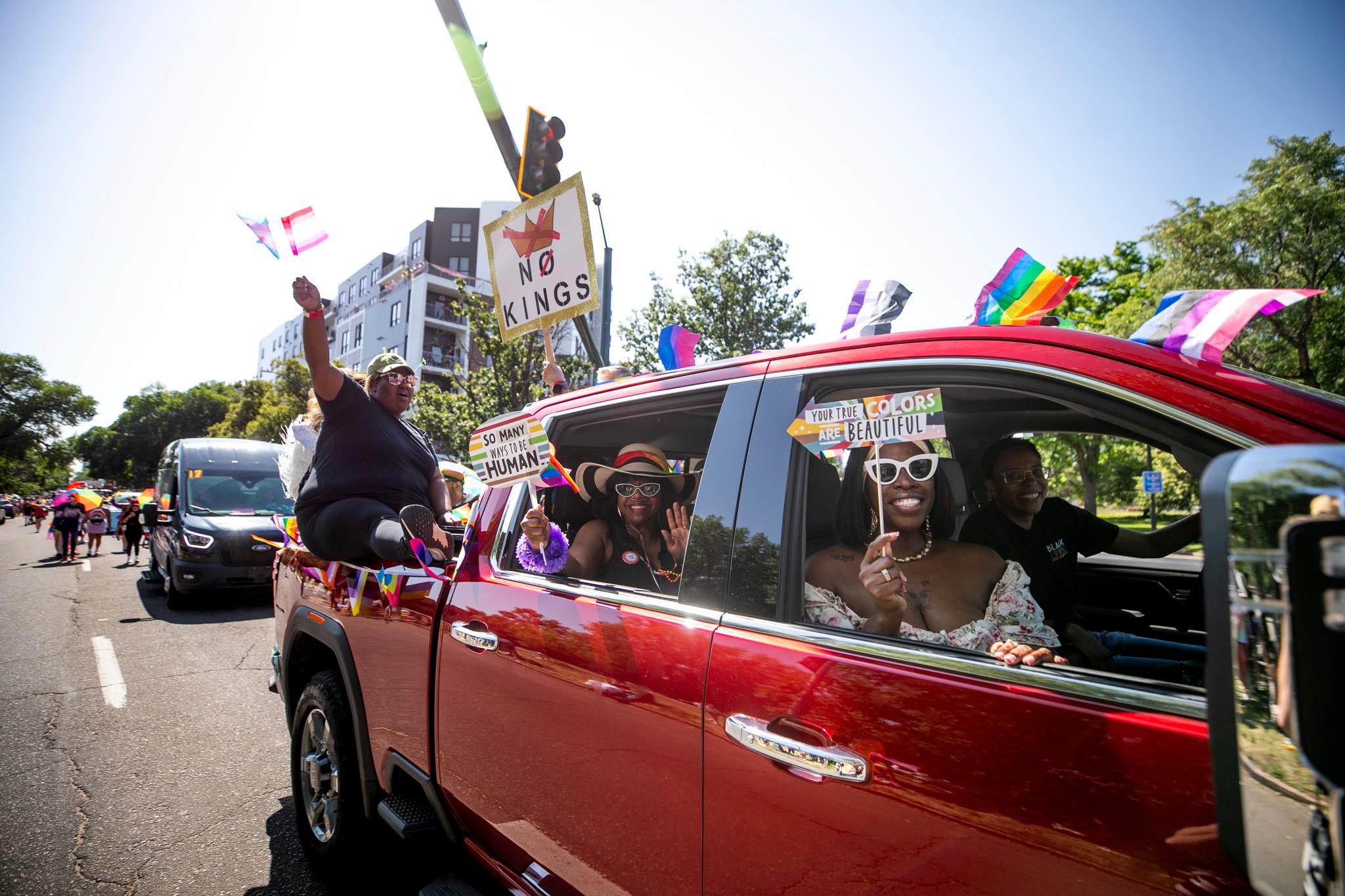
A man stands in a half-forgotten corner of Denver, scratchy plains grass brushing at his grey athletic shorts and paint splattered on his T-shirt. He's been working here for nearly two months. His canvas is a 200-foot wall. His audience sits aboard the passenger trains that groan past every few minutes. His subject is personal.
"This is my son. His face is down here," he says, stepping through the grass toward the north end of this sprawling mural. There, at the edge of the building, is a boy's face rendered in geometric lines and shades of blue and pink.
Across the rest of the wall, there's a message in the kind of curled letters you more often see on the window of a boutique.
"i can't breathe," it says.

This is the work of Belove, an anonymous artist who has been quietly painting walls in Denver with monumental images of his son.
He has scattered at least ten of these murals in unexpected places -- here on a warehouse, there on a row house, on a garage, on the wall of an architect's studio. They are presented without explanation or fanfare -- but they are unmistakable. As soon as you've seen one, they seem to appear throughout the city.
I wrote about this work last year, searching but failing to find the artist. A little more than a year later, the painter emailed me to say that he had read the piece. We agreed to meet at the site of his latest work.
Titled "i can't breathe," it makes perhaps the most explicit statement of his public murals, a reference to the dying words of Eric Garner, a black man killed by police in New York while he was selling loose cigarettes.

"I was probably 19," Belove says.
"I walked into a room, and this other kid was like, 'Dude, are you black?'"
"No," he told the kid. "I'm purple."
It was a summary of a young life lived outside America's binary definition of race.
"I had a black father and a white mother -- very different life experiences came together and created me," he says.
And that idea, of being purple, was "an attempt to just disrupt that, disrupt the need to know, disrupt the need to compartmentalize, to stick to dichotomies that are harmful."
Each work is a depiction of his own young son. They are the recognizable images that he never had as the child -- images that are not filtered through white perceptions of race and black people, he says.
"I took it upon myself to say there is something I can do, to be the one presenting him," he says. "And it's hard because it felt really vulnerable -- it still does. It's your child."

It's not illegal, and it's not for profit.
Murals have become enormously popular in the age of Instagram. Buildings' owners have embraced them, commissioning huge works on new and redeveloped structures.
In his writing, Belove says that the form is being corrupted in the service of gentrification.
"you want to play around in the city and celebrate the artform, without paying any mind to who it is harming if it is only created for your entertainment? 'street art' is being used and exploited to the very detriment of the communities from which it grew," a post on his website reads.
Art is not a full-time job for Belove. He is a teacher and student, he says, originally from San Francisco and here in Denver for "a while," though he declines to give much personal detail.
He painted his first wall in Denver without permission.
"I just did it. It was a space that was needing love." Now, he says, he has "a real healthy fear of losing my freedom, so I don't do that anymore."
Instead, he finds spaces that call to him. They seem to appear in neighborhoods at different stages of gentrification, from a residence in West Colfax to the industrial flank of Elyria-Swansea. Often enough, they are places where historic policies of housing discrimination kept black families down.
Then he approaches their owners.
"I don't try to convince them, at all. It's just, 'Here's who I am and what I do. Is this a fit?' And if it's not, we say peace and love and go our separate ways," he says. "And if it is, I generally start working that day."


"I don't tell people what I'm going to paint ahead of time," he says. "I don't know what I'm going to paint."
The work emerges as he spends time in a place. Sometimes it comes from conversation with the residents or the kids passing by. The site of his latest, largest work is frequented by young artists, and the drainage channel alongside the wall is scattered with the furniture of an encampment.
"I don't know (what I'll paint) because I don't come into a space and insert my narrative ... and say, 'This fits, just deal with it,'" he explains.
"That's the exact mentality I try to combat with my art, because that is destructive, and that oppresses people."
His son, he says, is starting to understand. He'll come and paint with his father. "I think he thinks it's cool," Belove says. "He's of the age, the last year or so, we've been starting to dive into some of the deeper reasons behind it."

It's not just for his son.
These paintings are an invitation to engage.
The use of otherworldly colors delays the recognition of race, subverting the binary just as Belove did in declaring himself to be "purple." It forces the white viewer to discard the old American frame of race, much like Kehinde Wiley's paintings do by placing young black men in "traditional" Western portraits. Belove points to the Los Angeles artist El Mac's painted mural faces as an inspiration.
"We're still getting to a point where we're recognizing the fully human nature of black people and black bodies," Belove says.
His son is "a lighter hue than me. But even so, if I paint his brown complexion ... certain people just won't have access because they're going to say, 'That's less than, and I'm not buying in.' And the whole point is to change that."
There is a "post-racial aspect" to the images that he paints with rollers onto Denver's walls, he says. Yet it is not a validation of the "I don't see color" philosophy. It's not meant to say that we can simply ignore race and the American laws that demeaned people as subhuman and undeserving.
"We absolutely created race, and it's constantly changing," he says, "and it's a testament to the fact that it's nothing but socially constructed -- but it can be socially deconstructed."
It's a reminder, he writes: "you are welcome. come and share in our humanity. but do not use our humanity for your sustenance only to toss our bodies to the side once you've had your fill and they are no longer of use to you. collectively we deserve better."














